140 GHz Ultra-Long Bessel–Like Beam with Near-Wavelength Beamwidth
Abstract
:1. Introduction
2. Ray-Tracing Simulations of Axicon-Generated Bessel–Like Beams
3. Measurement Setup for Focusing Beam Profiles
4. Results and Discussion
4.1. Ray-Tracing Simulation Results on the Bessel–Like Beam Shaping
4.2. Beam-Profile Measurement Results on the Bessel–Like Beam Propagation
5. Conclusions
Author Contributions
Funding
Conflicts of Interest
References
- Afsah-Hejri, L.; Hajeb, P.; Ara, P.; Ehsani, R.J. A comprehensive review on food applications of terahertz spectroscopy and imaging. Compr. Rev. Food Sci. Food Saf. 2019, 18, 1563–1621. [Google Scholar] [CrossRef]
- Ren, A.; Zahid, A.; Fan, D.; Yang, X.; Imran, M.A.; Alomainy, A.; Abbasi, Q.H. State-of-the-art in terahertz sensing for food and water security–A comprehensive review. Trends Food Sci. Technol. 2019, 85, 241–251. [Google Scholar] [CrossRef] [Green Version]
- Lee, D.-K.; Kang, J.-H.; Lee, J.-S.; Kim, H.-S.; Kim, C.; Kim, J.H.; Lee, T.; Son, J.-H.; Park, Q.-H.; Seo, M. Highly sensitive and selective sugar detection by terahertz nano-antennas. Sci. Rep. 2015, 5, 1–7. [Google Scholar] [CrossRef] [PubMed]
- Shin, H.J.; Choi, S.-W.; Ok, G. Qualitative identification of food materials by complex refractive index mapping in the terahertz range. Food Chem. 2018, 245, 282–288. [Google Scholar] [CrossRef] [PubMed]
- Karpowicz, N.; Zhong, H.; Zhang, C.; Lin, K.-I.; Hwang, J.-S.; Xu, J.; Zhang, X.-C. Compact continuous-wave subterahertz system for inspection applications. Appl. Phys. Lett. 2005, 86, 054105. [Google Scholar] [CrossRef] [Green Version]
- Song, Q.; Zhao, Y.; Redo-Sanchez, A.; Zhang, C.; Liu, X.J.O.C. Fast continuous terahertz wave imaging system for security. Opt. Commun. 2009, 282, 2019–2022. [Google Scholar] [CrossRef]
- Ok, G.; Choi, S.-W.; Park, K.H.; Chun, H.S. Foreign object detection by sub-terahertz quasi-Bessel beam imaging. Sensors 2013, 13, 71–85. [Google Scholar] [CrossRef] [Green Version]
- Wang, D.; Li, B.; Rong, L.; Xu, Z.; Zhao, Y.; Zhao, J.; Wang, Y.; Zhai, C. Extended depth of field in continuous-wave terahertz computed tomography based on Bessel beam. Opt. Commun. 2019, 432, 20–26. [Google Scholar] [CrossRef]
- Ok, G.; Park, K.; Lim, M.-C.; Jang, H.-J.; Choi, S.-W. 140-GHz subwavelength transmission imaging for foreign body inspection in food products. J. Food Eng. 2018, 221, 124–131. [Google Scholar] [CrossRef]
- Durnin, J.M., Jr. Nondiffracting beams. Opt. News 1987, 13, 27. [Google Scholar] [CrossRef]
- Bitman, A.; Goldring, S.; Moshe, I.; Zalevsky, Z. Computed tomography using broadband Bessel THz beams and phase contrast. Opt. Lett. 2014, 39, 1925–1928. [Google Scholar] [CrossRef] [PubMed]
- Meng, H.; Xiang, B.; Zhang, J.; Dou, W.; Yu, Y. The generation of Bessel beam and its application in millimeter wave imaging. J. Infrared Millim. Terahertz Waves 2014, 35, 208–217. [Google Scholar] [CrossRef]
- Busch, S.; Town, G.; Scheller, M.; Koch, M. Focus free terahertz reflection imaging and tomography with Bessel beams. J. Infrared Millim. Terahertz Waves 2015, 36, 318–326. [Google Scholar] [CrossRef]
- Niu, L.; Wang, K.; Yang, Y.; Wu, Q.; Ye, X.; Yang, Z.; Liu, J.; Yu, H. Diffractive elements for zero-order Bessel beam generation with application in the terahertz reflection imaging. IEEE Photonics J. 2018, 11, 1–12. [Google Scholar] [CrossRef]
- Minkevičius, L.; Jokubauskis, D.; Kašalynas, I.; Orlov, S.; Urbas, A.; Valušis, G. Bessel terahertz imaging with enhanced contrast realized by silicon multi-phase diffractive optics. Opt. Express 2019, 27, 36358–36367. [Google Scholar] [CrossRef]
- Banerji, S.; Meem, M.; Majumder, A.; Sensale-Rodriguez, B.; Menon, R. Extreme-depth-of-focus imaging with a flat lens. Optica 2020, 7, 214–217. [Google Scholar] [CrossRef]
- Vetter, C.; Steinkopf, R.; Bergner, K.; Ornigotti, M.; Nolte, S.; Gross, H.; Szameit, A. Realization of Free-Space Long-Distance Self-Healing Bessel Beams. Laser Photonics Rev. 2019, 13, 1900103. [Google Scholar] [CrossRef]
- Mahon, R.J.; Lanigan, W.; Murphy, J.A.; Trappe, N.; Withington, S.; Jellema, W. Novel Techniques for Millimeter Wave Imaging Systems Operating at 100GHz; Passive Millimeter-Wave Imaging Technology VIII, 2005; International Society for Optics and Photonics: Bellingham, WA, USA, 2005; pp. 93–100. [Google Scholar]
- Belyi, V.; Forbes, A.; Kazak, N.; Khilo, N.; Ropot, P. Bessel–like beams with z–dependent cone angles. Opt. Express 2010, 18, 1966–1973. [Google Scholar] [CrossRef] [Green Version]
- Saikaley, A.; Chebbi, B.; Golub, I. Imaging properties of three refractive axicons. Appl. Opt. 2013, 52, 6910–6918. [Google Scholar] [CrossRef]
- Yao, Z.; Jiang, L.; Li, X.; Wang, A.; Wang, Z.; Li, M.; Lu, Y. Non-diffraction-length, tunable, Bessel–like beams generation by spatially shaping a femtosecond laser beam for high-aspect-ratio micro-hole drilling. Opt. Express 2018, 26, 21960–21968. [Google Scholar] [CrossRef]
- Brzobohatý, O.; Čižmár, T.; Zemánek, P. High quality quasi-Bessel beam generated by round-tip axicon. Opt. Express 2008, 16, 12688–12700. [Google Scholar] [CrossRef] [PubMed]
- Goldsmith, P.F. Quasi-optical techniques. Proc. IEEE 1992, 80, 1729–1747. [Google Scholar] [CrossRef]
- Ahmad, F.; Amin, M.G.; Kassam, S.A. Synthetic aperture beamformer for imaging through a dielectric wall. IEEE Trans. Aerosp. Electron. Syst. 2005, 41, 271–283. [Google Scholar] [CrossRef]
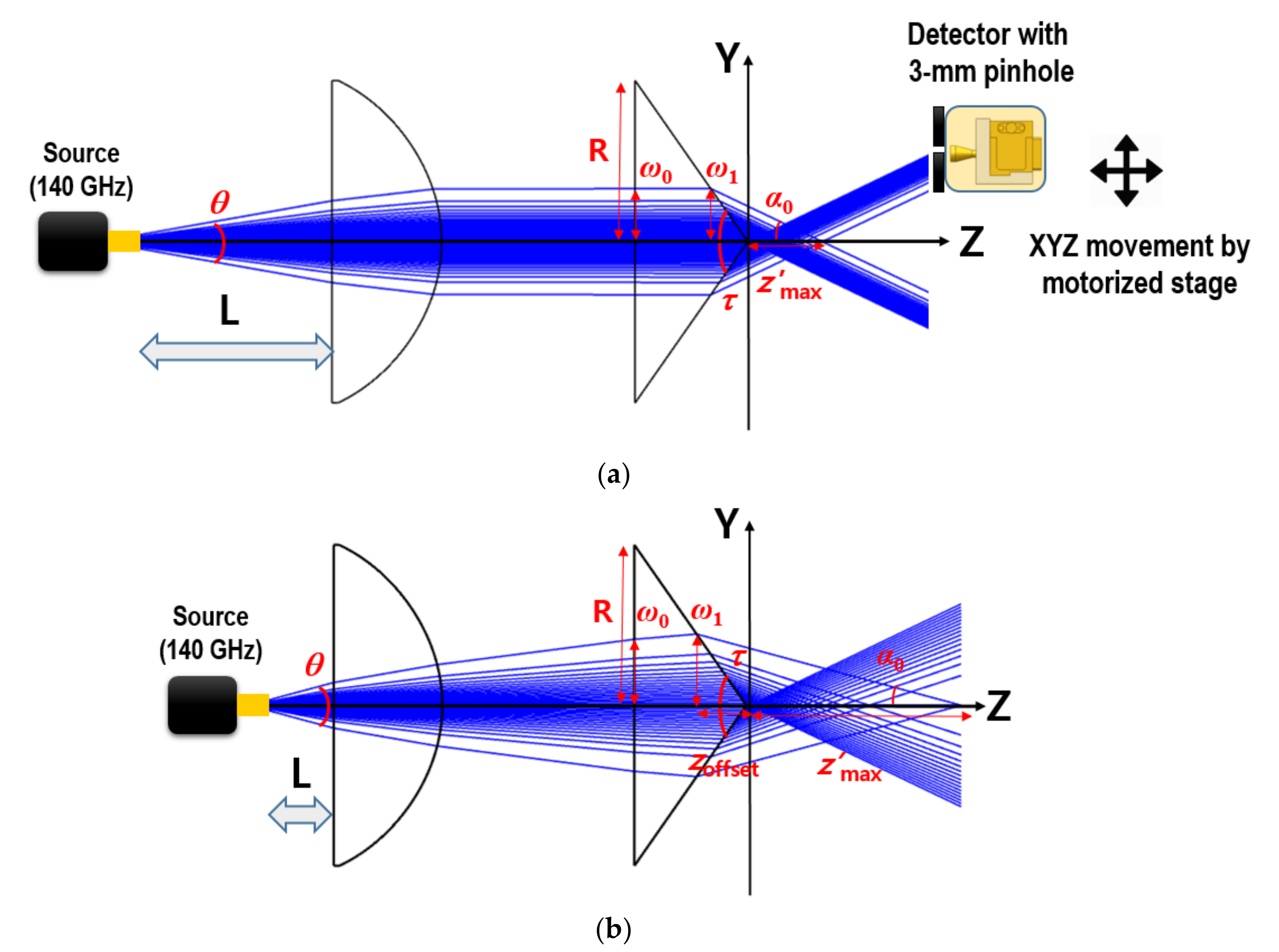

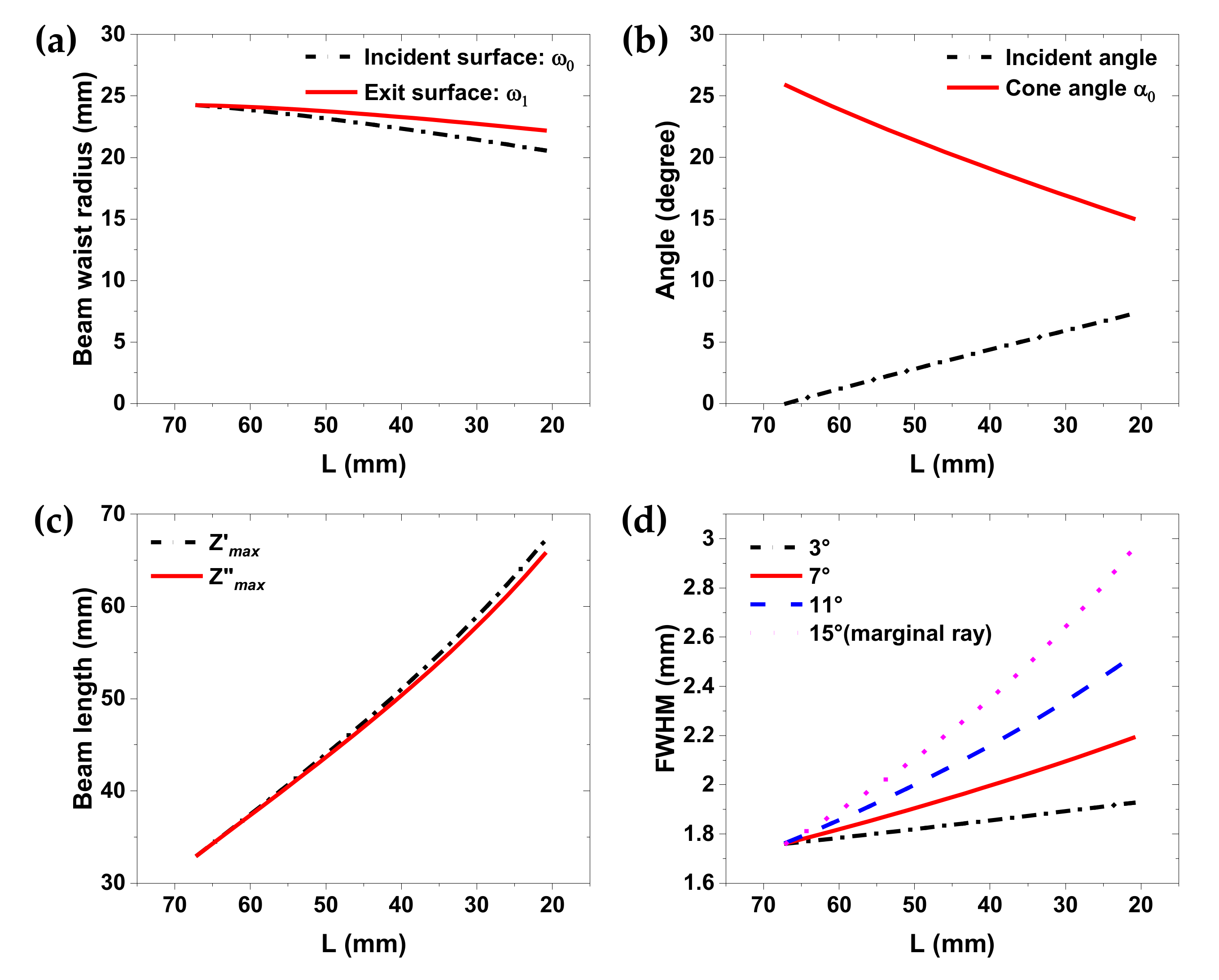
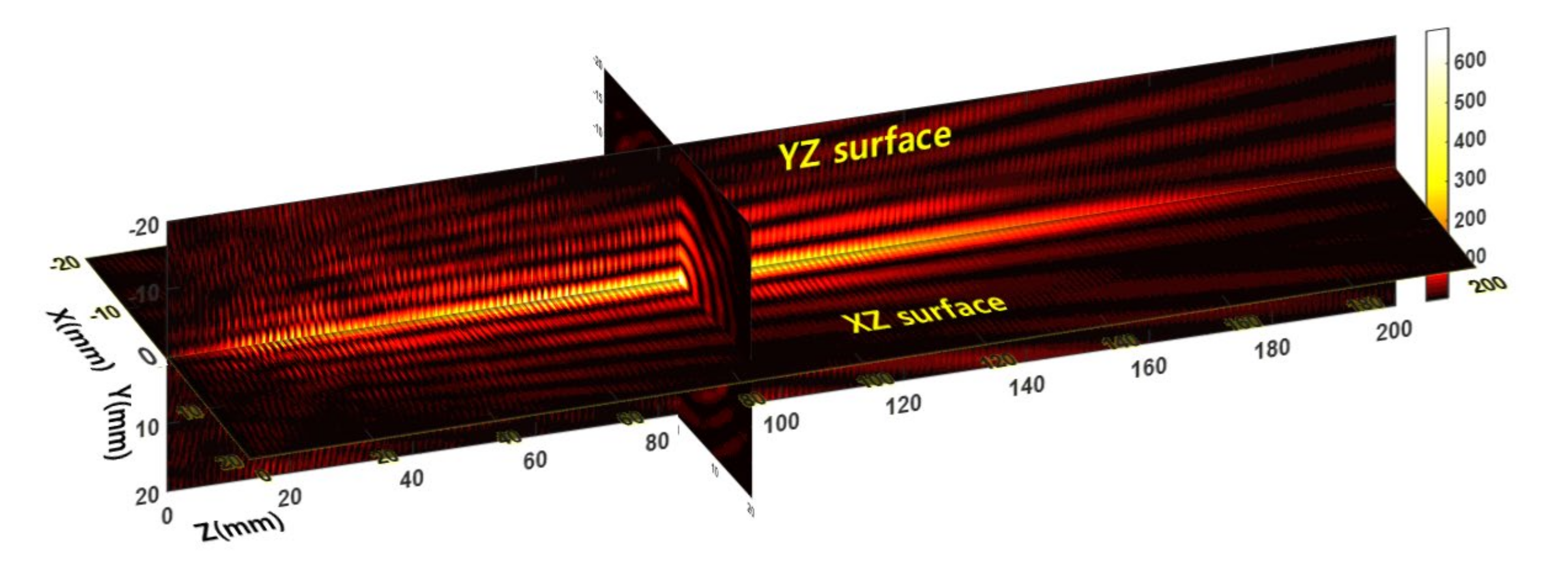
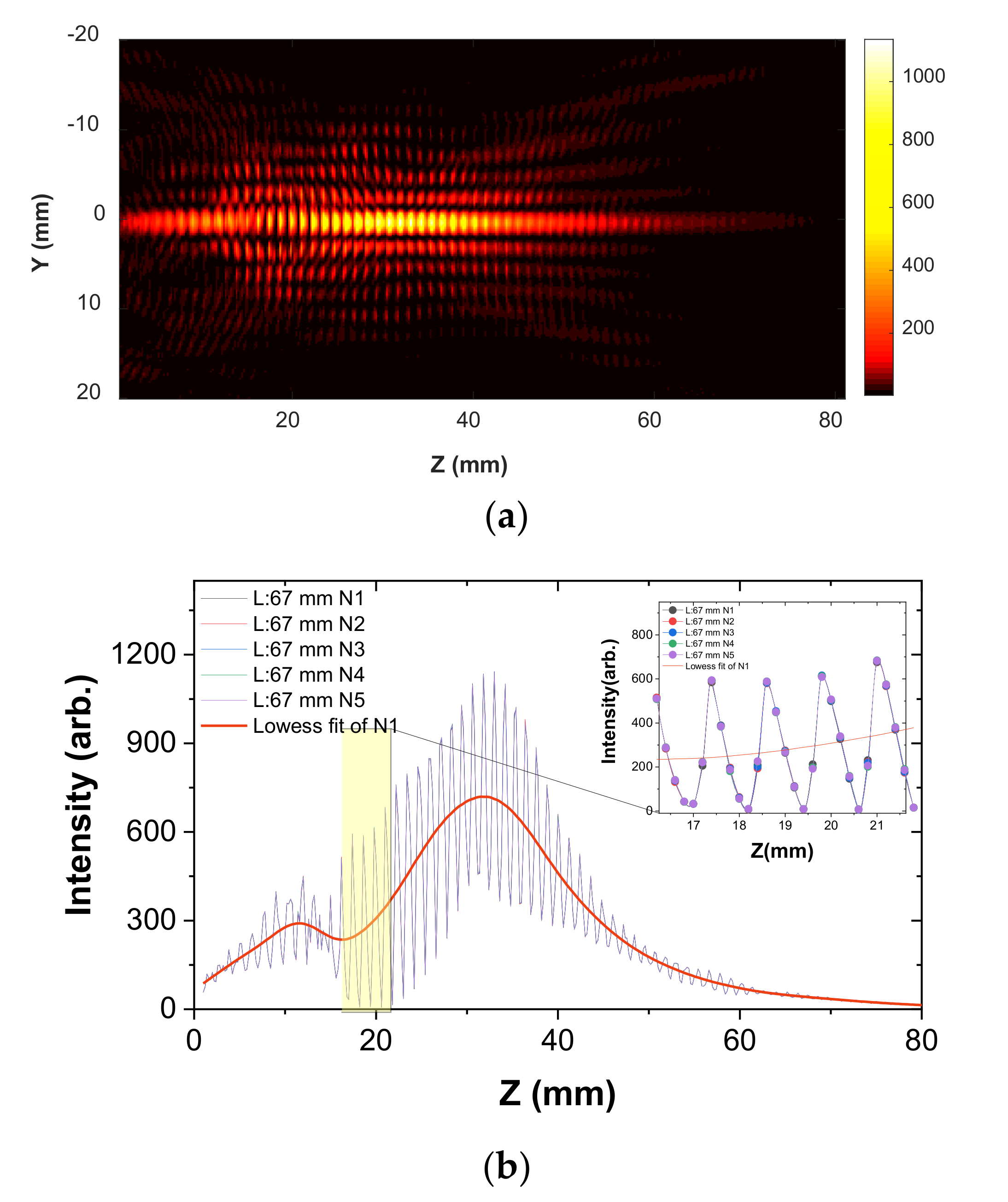
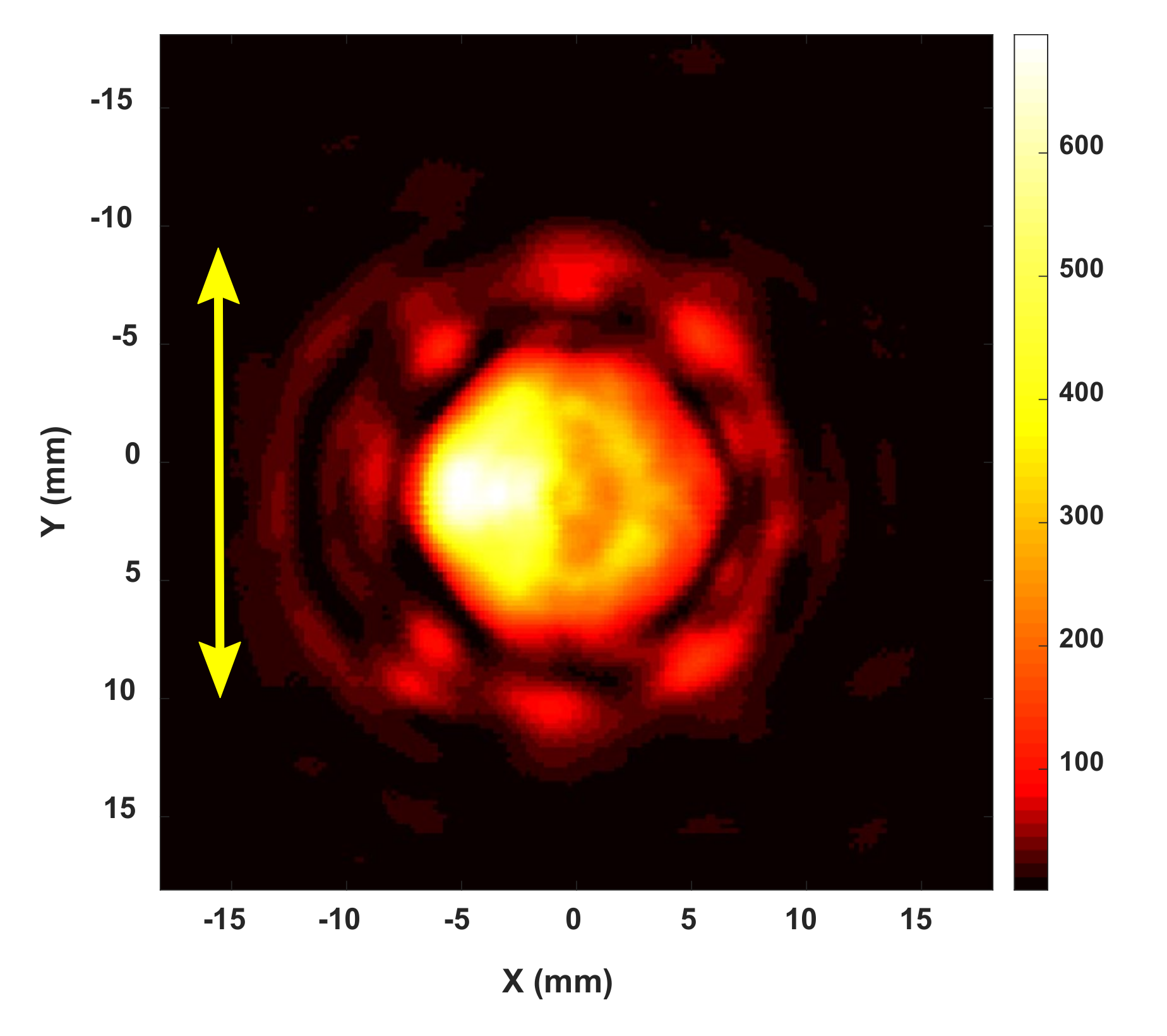
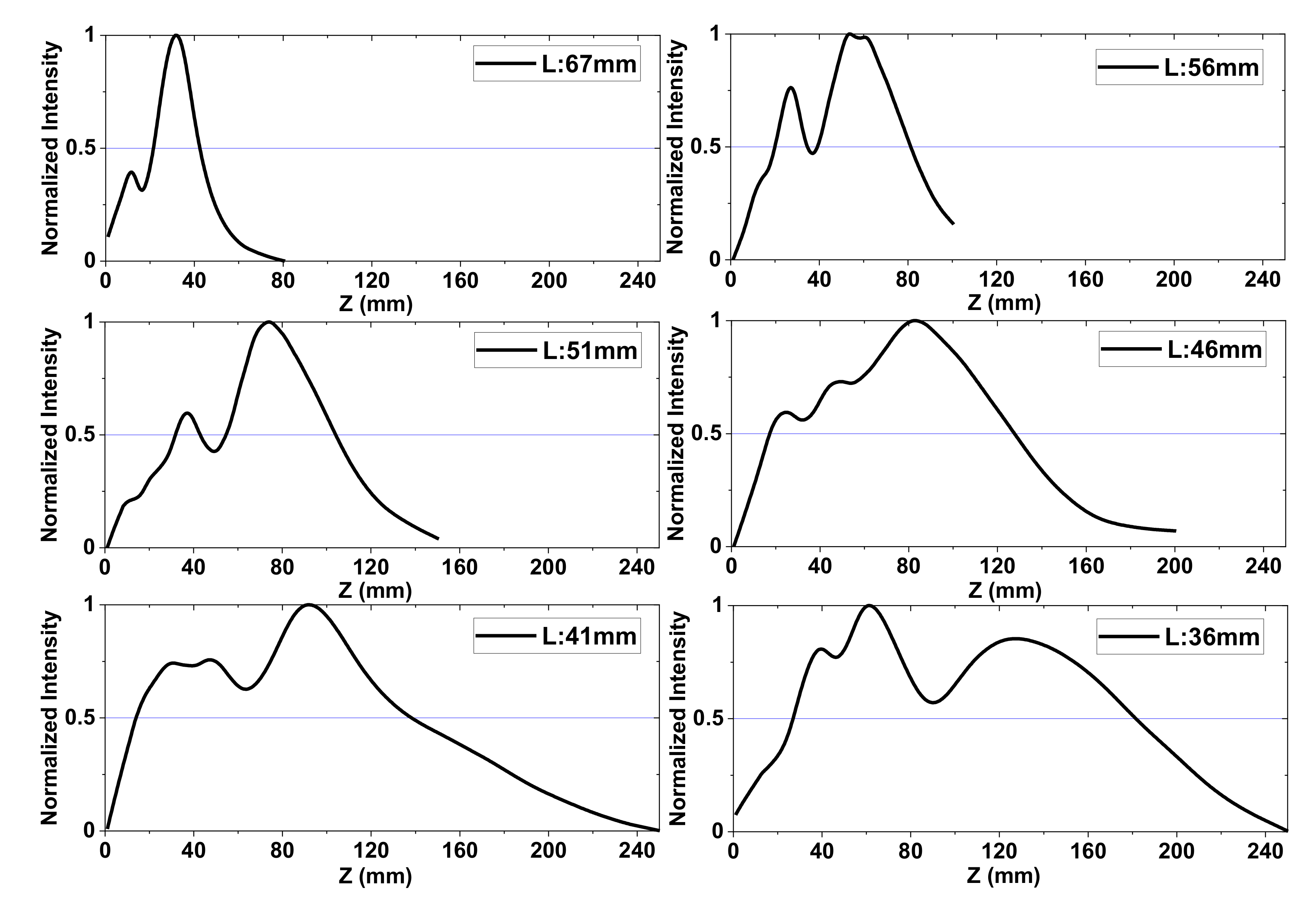
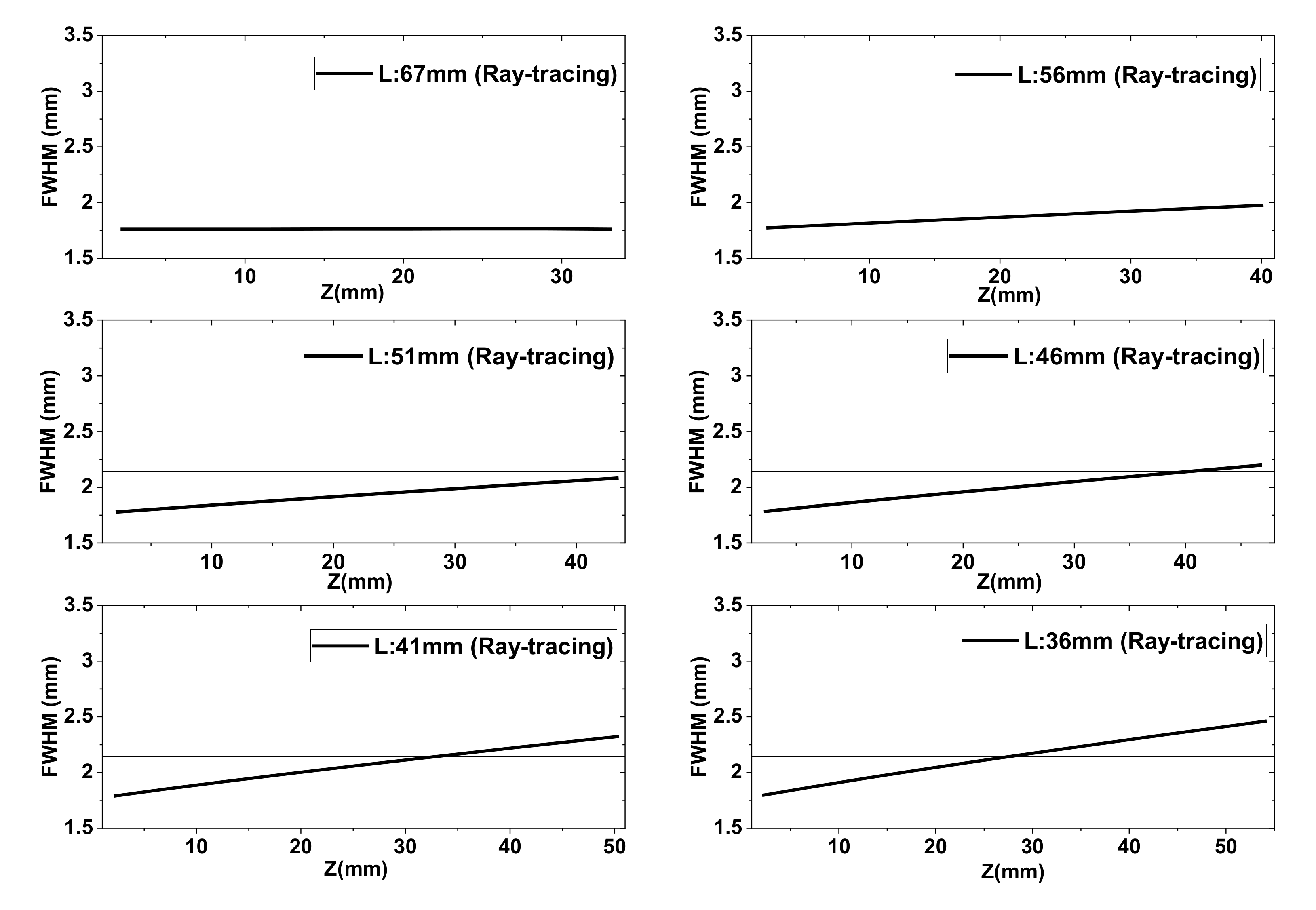

| Axis | Maximum Scan Length | Minimum Scan Resolution | Maximum Scan Speed |
|---|---|---|---|
| X-axis | 800 mm | 1.0 μm | 2 m/s |
| Y-axis | 300 mm | 1.125 μm | 1 m/s |
| Z-axis | 800 mm | 2.5 μm | 1 m/s |
| Lens Distance (L) | DOF | Beamwidth (Mean Values) | ||||
|---|---|---|---|---|---|---|
| Ray Tracing | Measurement | Ray Tracing | Measurement | |||
| 67 mm | 33 mm | 21 mm | 1.76 mm | 0.82 λ | 1.81 mm | 0.84 λ |
| 56 mm | 40 mm | 61 mm | 1.87 mm | 0.87 λ | 2.19 mm | 1.02 λ |
| 51 mm | 43 mm | 70 mm | 1.92 mm | 0.90 λ | 2.48 mm | 1.16 λ |
| 46 mm | 47 mm | 109 mm | 1.98 mm | 0.92 λ | 2.60 mm | 1.21 λ |
| 41 mm | 50 mm | 123 mm | 2.04 mm | 0.95 λ | 2.77 mm | 1.29 λ |
| 36 mm | 54 mm | 154 mm | 2.10 mm | 0.98 λ | 3.01 mm | 1.40 λ |
Publisher’s Note: MDPI stays neutral with regard to jurisdictional claims in published maps and institutional affiliations. |
© 2020 by the authors. Licensee MDPI, Basel, Switzerland. This article is an open access article distributed under the terms and conditions of the Creative Commons Attribution (CC BY) license (http://creativecommons.org/licenses/by/4.0/).
Share and Cite
Ok, G.; Park, K.J. 140 GHz Ultra-Long Bessel–Like Beam with Near-Wavelength Beamwidth. Sensors 2020, 20, 6791. https://doi.org/10.3390/s20236791
Ok G, Park KJ. 140 GHz Ultra-Long Bessel–Like Beam with Near-Wavelength Beamwidth. Sensors. 2020; 20(23):6791. https://doi.org/10.3390/s20236791
Chicago/Turabian StyleOk, Gyeongsik, and Kee Jai Park. 2020. "140 GHz Ultra-Long Bessel–Like Beam with Near-Wavelength Beamwidth" Sensors 20, no. 23: 6791. https://doi.org/10.3390/s20236791





